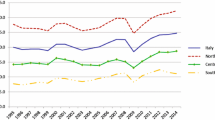Abstract
Due to the rapid appreciation of RMB, the consistent declining of the US economy and other uncertain factors, China’s export volume to the United States has declined. The paper first chooses six industries to divide them into three groups based on per capita possession of capital, then employs the monthly data from 2001 to 2008 to carry out EG two-step cointegration test, and finally analyzes the impacts of the US economic growth and the exchange rate variability on different export industries. Empirical results show that the labor-intensive industries are most susceptible to fluctuations brought by economic growth and real exchange rate, while those industries with higher per capita possession of capital are less susceptible to external factors. In the short run, the export of labor-intensive products gives an advantage to China’s foreign trade development, but in the long-run, these industries will be affected greatly by various uncertain factors and the advantages of China’s labor-intensive export industries will disappear with the shift of the international division. Therefore, the only way to guarantee the dominant position of China’s foreign trade is to develop capital and technology intensive export industries and upgrade export structure.
Similar content being viewed by others
References
Chou W L (2000). Exchange rate variability and China’s export. Journal of Comparative Economics, 28(1): 61–79
Chua S Y, Sharma S C (1998). An investigation of the effects of prices and exchange rates on trade flows in East Asia. Asian Economic Journal, 12(3): 253–271
Goldstein M, Khan M S (1985). Income and price effects in foreign trade. Handbook of International Economics, Jones R W, Kenen P B (eds). North-Holland: Amsterdam, 1041–1105
Klaassen F (2004). Why is it so difficult to find an effect of exchange rate risk on trade? Journal of International Money and Finance, 23(5): 817–839
Lall S (2000). The technological structure and performance of developing country manufactured exports, 1995–1998. Oxford Development Studies, 28(3): 337–369
Lall S, John W, Zhang Jinkang (2006). The sophistication of exports: A new measure of product characteristics. World Development, 34(2): 222–237
Marquez J, Schindler J (2007). Exchange-rate effects on China’s trade. Review of International Economics, 15(5): 837–885
Rose A K, Yellen J L (1989). Is there a J-curve? Journal of Monetary Economics, 24(1): 53–68
Rose A K (1991). The role of exchange rates in a popular model of international trade: Does the ‘Marshall-Lerner’ condition hold? Journal of International Economics, 30(2): 301–316
Sawyer W C, Sprinkle R L (1996). The demand for imports and exports in the U.S.: A survey. Journal of Economics and Finance, 20(1): 147–178
Wilson P (2001). Exchange rate and the trade balance for dynamic Asian economics—Does the J-curve exit for Singapore, Malaysia and Korea? Open Economies Review, 12(4): 389–413
Wilson J F, Takacs W E (1979). Differential responses to price and exchange rate influences in the foreign trade of selected industrial countries. Review of Economics and Statistics, 61(2): 267–279
曹 阳, 李 剑武 (Cao Yang, Li Jianwu) (2006). 人民币实际汇率水平与波动对进出口贸易的影响——基于1980–2004 年的实证研究 (Impact of volatility of real exchange rates of RMB on import and export trade—based on the empirical study from 1980–2004). 世界经济研究, (8): 56–59
江 小涓 (Jiang Xiaojuan) (2007). 我国出口商品结构的决定因素和变化趋势 (Determinants and trends of China’s export goods structure upgrading). 经济研究, (5): 5–17
卢 向前, 戴 国强 (Lu Xiangqian, Dai Guoqiang) (2005). 人民币实际汇率波动对我国进出口的影响: 1994–2003 (The Influence of fluctuation of real RMB exchange rate to Chinese import and export: 1994–2003). 经济研究, (5): 31–39
齐 俊妍 (Qi Junyan) (2008). 中国是否出口了更多高技术产品—基于技术含量和附加值的考察 (Does China export more high technology products? A review based on the technology content and value added). 世界经济研究, (9): 42–48
谢 建国, 陈 漓高 (Xie Jianguo, Chen Ligao) (2002). 人民币汇率与贸易收支: 协整研究与冲击分解 (The relationship between RMB exchange rate and trade balance: The cointegration study and impact decomposition). 世界经济, (9): 27–34
姚 洋, 章 林峰 (Yao Yang, Zhang Linfeng) (2008). 中国本土企业出口竞争优势和技术变迁分析 (The competitive advantages and technology changes of China-based export enterprises). 世界经济, (3): 5–13
Author information
Authors and Affiliations
Corresponding author
Additional information
__________
Translated from Zhongguo Gongye Jingji 中国工业经济 (China Industrial Economics), 2009, (5): 15–24
About this article
Cite this article
Ba, S., Shen, S. Research on China’s export structure to the US: Analysis based on the US economic growth and exchange rate. Front. Econ. China 5, 339–355 (2010). https://doi.org/10.1007/s11459-010-0101-5
Published:
Issue Date:
DOI: https://doi.org/10.1007/s11459-010-0101-5




